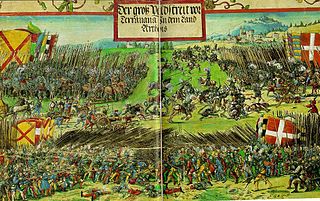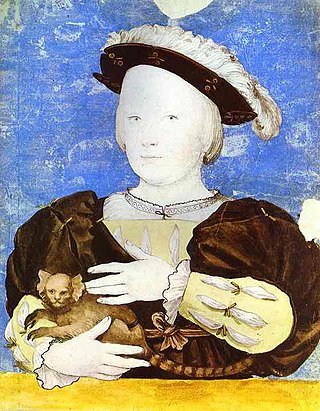Related Research Articles

Catherine of Aragon was Queen of England as the first wife of King Henry VIII from their marriage on 11 June 1509 until its annulment on 23 May 1533. She was Princess of Wales while married to Henry's elder brother, Arthur, Prince of Wales, for a short period before his death.

Henry VIII was King of England from 22 April 1509 until his death in 1547. Henry is known for his six marriages and his efforts to have his first marriage annulled. His disagreement with Pope Clement VII about such an annulment led Henry to initiate the English Reformation, separating the Church of England from papal authority. He appointed himself Supreme Head of the Church of England and dissolved convents and monasteries, for which he was excommunicated by the pope.

Mary I, also known as Mary Tudor, and as "Bloody Mary" by her Protestant opponents, was Queen of England and Ireland from July 1553 and Queen of Spain and the Habsburg dominions as the wife of King Philip II from January 1556 until her death in 1558. She is best known for her vigorous attempt to reverse the English Reformation, which had begun during the reign of her father, King Henry VIII. Her attempt to restore to the Church the property confiscated in the previous two reigns was largely thwarted by Parliament, but during her five-year reign, Mary had over 280 religious dissenters burned at the stake in the Marian persecutions.

Thomas Wolsey was an English statesman and Catholic cardinal. When Henry VIII became King of England in 1509, Wolsey became the king's almoner. Wolsey's affairs prospered and by 1514 he had become the controlling figure in virtually all matters of state. He also held important ecclesiastical appointments. These included the Archbishop of York—the second most important role in the English church—and that of papal legate. His appointment as a cardinal by Pope Leo X in 1515 gave him precedence over all other English clergy.

The House of Tudor was an English and Welsh dynasty that held the throne of England from 1485 to 1603. They descended from the Tudors of Penmynydd, a Welsh noble family, and Catherine of Valois. The Tudor monarchs ruled the Kingdom of England and the Lordship of Ireland for 118 years with five monarchs: Henry VII, Henry VIII, Edward VI, Mary I and Elizabeth I. The Tudors succeeded the House of Plantagenet as rulers of the Kingdom of England, and were succeeded by the Scottish House of Stuart. The first Tudor monarch, Henry VII, descended through his mother from the House of Beaufort, a legitimised branch of the English royal House of Lancaster, a cadet house of the Plantagenets. The Tudor family rose to power and started the Tudor period in the wake of the Wars of the Roses (1455–1487), which left the main House of Lancaster extinct in the male line.

Year 1540 (MDXL) was a leap year starting on Thursday of the Julian calendar.

Year 1536 (MDXXXVI) was a leap year starting on Saturday of the Julian calendar.

Year 1511 (MDXI) was a common year starting on Wednesday of the Julian calendar.

Anne Boleyn was Queen of England from 1533 to 1536, as the second wife of King Henry VIII. The circumstances of her marriage and execution, by beheading for treason, made her a key figure in the political and religious upheaval that marked the start of the English Reformation.

Anne of Cleves was Queen of England from 6 January to 12 July 1540 as the fourth wife of Henry VIII. Little is known about Anne before 1527, when she became betrothed to Francis, Duke of Bar, son and heir of Antoine, Duke of Lorraine, although their marriage did not proceed.

The Field of the Cloth of Gold was a summit meeting between King Henry VIII of England and King Francis I of France from 7 to 24 June 1520. Held at Balinghem, between Ardres in France and Guînes in the English Pale of Calais, it was a very expensive display of wealth by both kings.

The Battle of the Spurs or (Second) Battle of Guinegate took place on 16 August 1513. It formed a part of the War of the League of Cambrai of 1508 to 1516, during the Italian Wars. King Henry VIII of England and Emperor Maximilian I were besieging the French town of Thérouanne in Artois. Henry's camp was at Guinegate. A large body of French heavy cavalry under Jacques de La Palice was covering an attempt by light cavalry to bring supplies to the besieged garrison. English and Imperial troops surprised and routed the French cavalry. The battle resulted in the precipitate flight and extensive pursuit of the French. During the pursuit, a number of notable French leaders and knights were captured. After the fall of Thérouanne, Henry VIII besieged and took Tournai.

The Kingdom of England was a sovereign state on the island of Great Britain from the early tenth century, when it was unified from various Anglo-Saxon kingdoms, until 1 May 1707, when it united with Scotland to form the Kingdom of Great Britain, which would later become the United Kingdom. The Kingdom of England was among the most powerful states in Europe during the medieval and early modern periods.

The First Siege of Boulogne took place from 19 July to 14 September 1544 and the Second Siege of Boulogne took place in October 1544.

Henry Brandon, Earl of Lincoln was the youngest child and second son born to Charles Brandon, 1st Duke of Suffolk and Mary Tudor, Queen of France, who was a daughter of Henry VII, King of England. Thus Henry Brandon was nephew to King Henry VIII. His older sisters were Lady Frances Brandon and Lady Eleanor Brandon.
Events from the 1500s in England.
Events from the 1510s in England.
The Chronicle of King Henry VIII of England, commonly known as the Spanish Chronicle, is a chronicle written during the reigns of Henry VIII and Edward VI by an unknown author, based on eyewitness accounts such as that of Francisco Felipe.
Events from the year 1514 in France.
Pedro de Gamboa was a Spanish soldier who fought for Henry VIII of England in France and Scotland.
References
- ↑ The Spanish Chronicle, xxii,
- ↑ "Chronicle of King Henry VIII. Of England: Being a Contemporary Record of Some of the Principal". G. Bell and sons. 1889.